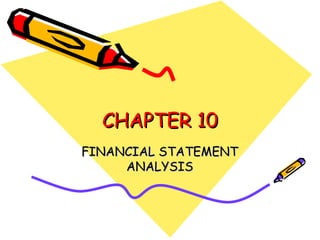
Ch 9 financial statement analysis
- 1. CHAPTER 10 FINANCIAL STATEMENT ANALYSIS
- 2. LEARNING OBJECTIVES • To describe & explain the different financial ratios • To calculate & interpret the main financial ratios • To explain the use of ratios in analyzing the performances of the business • To explain the significance of each financial ratios
- 3. INTRODUCTION • The real value of the financial statements lies in the fact that they can be used in predicting the firm’s future earnings and dividends, as well as the risk. • The financial statements are analyzed through the use of various tools, & one of the tools widely used is financial ratio
- 4. OBJECTIVE OF FINANCIAL STATEMENT ANALYSIS • Financial statement analysis is used in predicting the future (investor), & to anticipate future conditions, planning actions that influence future events (management). • 3 objectives of financial statement analysis: a) To identify the weaknesses as well as strengths of a business b) The business can take appropriate steps to overcome their weaknesses c) To enable the business to improve its overall financial situation in the future
- 5. THE USE OF RATIOS TO ANALYSE THE FINANCIAL STATEMENT • Two types of ratios are commonly used: LIQUIDITY RATIOS PROFITABILITY RATIOS i) CURRENT RATIO i) GROSS PROFIT MARGIN = Current Assets / Current = (Gross profit/Sales) x 100% Liabilities ii) ACID TEST @ QUICK ii) NET PROFIT MARGIN RATIO = (Net Profit/Sales) x 100% = (Current Assets – Stock) / Current Liabilities iii) STOCK TURNOVER iii) RETURN ON CAPITAL RATIO EMPLOYED (ROCE) = Cost of goods sold / = Net Profit / Capital Employed Average stock
- 6. LIQUIDITY RATIOS There are 3 ratios that measure the ability of a firm to meet its current obligations when they become due: i) CURRENT RATIO = Current Assets / Current Liabilities a) Tells about the firm’s ability to repay its current liabilities when they become due b) If current ratio is 2:1, this means that for every RM1 of current liabilities, the firm has RM2 of current assets to repay that RM1 of liabilities
- 7. LIQUIDITY RATIOS (cont’d) ii) ACID TEST OR QUICK RATIO = (Current Assets – Stock - #Prepayments) Current Liabilities a) A better measure of liquidity that the current ratio because it does not take into a/c the stock of a business which is the least liquid asset of the current asset b) # The prepayments is deducted because prepayments are considered to be liquid and generally it will not be converted back into cash c) The interpretation of this ratio is similar to the current ratio
- 8. LIQUIDITY RATIOS (cont’d) iii) STOCK TURNOVER RATIO = Cost of Goods Sold # Average Stock • Average stock= ½ (opening stock + closing stock) # – It tells how many times the stock has to be replaced within an accounting period – It gives an idea of how fast the goods are being sold – The higher the stock turnover figure, the better it is for the business – A reduction in stock turnover means that stocks may be piling up & not being sold. This could lead to liquidity crisis as money may be taken out of the bank to buy stocks that are not sold quickly enough.
- 9. PROFITABILITY RATIOS There are also 3 ratios that measure the performance of a firm during an accounting period i) GROSS PROFIT MARGIN = Gross Profit Sales X 100% – Represents the amount of gross profit for every RM1 of sales i.e. Gross profit margin = 20%, therefore for every RM100 of sales RM20 gross profit was made before any expenses were paid. – The amount of sales increases but the gross profit margin fallen by a relatively greater amount. The reasons are: a) cost of goods increases whilst selling price remains unchanged, b) in order to increase sales, selling price was being reduced
- 10. PROFITABILITY RATIOS (cont’d) ii) NET PROFIT MARGIN = Net Profit Sales X 100% – Represents the amount of net profit for every RM1 of sales i.e. Net profit margin = 10%, therefore for every RM100 of sales RM10 net profit was made. – This ratios reveal how far costs are covered by revenue & what is available to the owner of a business after considering all expenses incurred for a particular accounting period.
- 11. PROFITABILITY RATIOS (cont’d) iii) RETURN ON CAPITAL EMPLOYED = Net Profit X 100% #Capital Employed •# Capital employed = ½ (opening capital + closing capital) – Indicates the ability of the firm to make better use of capital employed also called Return on Investment – Capital employed is Fixed Assets + Current Assets – Current Liabilities or Owner’s Equity + Long Term Liability. – This is perhaps the most important of all profitability ratios
